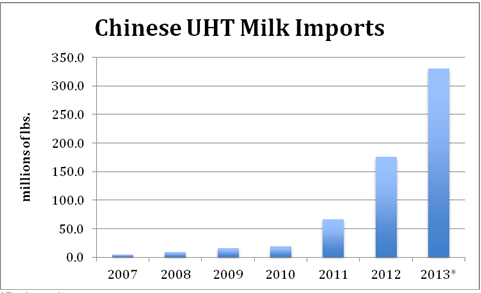
 Chinese demand for imported UHT milk is soaring. Consumption jumped from nearly 18 million lbs. in 2010 to a forecast 331 million lbs. this year, according to a new research study from the U.S. Dairy Export Council (USDEC). Demand scenarios suggest China's appetite for imported UHT milk could grow fourfold to more than 1.3 billion lbs. by 2020. USDEC is funded primarily by U.S. dairy farmers through the producer checkoff.
Chinese demand for imported UHT milk is soaring. Consumption jumped from nearly 18 million lbs. in 2010 to a forecast 331 million lbs. this year, according to a new research study from the U.S. Dairy Export Council (USDEC). Demand scenarios suggest China's appetite for imported UHT milk could grow fourfold to more than 1.3 billion lbs. by 2020. USDEC is funded primarily by U.S. dairy farmers through the producer checkoff."The rapid growth of China's UHT milk market is creating opportunities for the United States to further extend its reputation as a global supplier," says Ross Christieson, USDEC senior vice president, market research and analysis. "The U.S. industry produces large volumes of UHT milk annually, yet we have played only a minor role in serving booming Chinese consumption to date. Our research suggests that can and should change, particularly given that Chinese buyers have expressed growing interest in U.S. supply to meet spiraling demand."

UHT or ultra high temperature milk refers to milk heat-treated and packaged to provide a 9-12-month shelf life without refrigeration. The Chinese UHT import market was worth $76 million in 2012. In just the first six months of 2013, value topped $85 million. China is the largest packaged fluid milk importer in the world, and it is growing larger.
"While the growth is impressive, if you examine it in the context of the expansion of the Chinese dairy sector in general, it is a natural progression," says Christieson.
The nation's growing economy led to higher incomes, accelerated urbanization and cultivated the drive to consume more and better food. UHT milk has been one of many beneficiaries. Food safety concerns play a role in the appeal of imported UHT milk, but the surge in demand really began in 2011, well after the nation's melamine-tainted milk powder scandal, suggesting longer-term supply and demand factors are the primary drivers.
USDEC research explored how the United States might be able to gain a larger share of the imported UHT sector as the scenario of rising demand and limited domestic supply plays out.
Among the recommendations: U.S. suppliers need to develop products that better match Chinese expectations. For example, U.S. UHT milk is primarily consumed in half-pint and pint boxes and bottles, but the Chinese UHT market is dominated by 1-liter boxes.
"To be successful, we need to build capacity dedicated to exports that is closer to shipping points, as well as find a way to offer more competitive pricing for longer-term contract periods," Christieson said.
The opportunity is broader than strictly UHT milk and China. USDEC sees potential in other Asian markets, including the Philippines, and for additional products such as UHT cream and lactic acid beverages.
"One of the reasons U.S. exports are on pace for their fourth consecutive record year is U.S. suppliers' continuing movement toward broadening their product portfolios to meet the needs of overseas customers," says Tom Suber, USDEC president. "Time and again over the past few years we've seen the U.S. dairy industry invest in the people and the processes needed to develop products specifically to meet the needs of foreign markets: bulk gouda cheese, milk protein concentrate, nonfat dry milk/skim milk powder with tighter specifications and, most recently, whole milk powder. UHT milk is the next in line."
10.25.2013